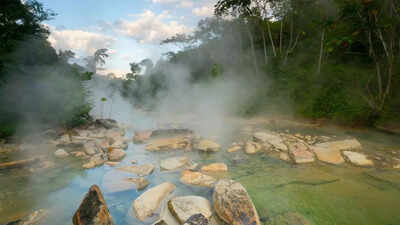Hidden deep within the Amazon rainforest, the Shanay-timpishka in Peru, more famously known as the Boiling River, is one of Earth’s most extraordinary natural wonders. This river is no ordinary body of water—it maintains extreme temperatures so high that they can reach 210°F (100°C), enough to boil living animals alive and inflict severe burns within seconds. Stretching approximately 9 kilometers, the river has intrigued scientists, explorers, and indigenous communities alike. Its existence far from any volcanic activity challenges conventional geological knowledge, making it both a cultural legend and a scientific enigma. For centuries, it has been revered and feared by locals who rely on it for daily living needs yet respect its dangerous power.
World’s Boiling River origins
The Boiling River was first introduced to the Western world through tales of Spanish conquistadors who ventured into the Amazon basin centuries ago in search of the fabled El Dorado, or the city of gold. Alongside descriptions of dense jungle canopies, poisoned-arrow-wielding warriors, and powerful shamans, they recounted a chilling natural phenomenon—a river so hot it could boil a human alive.For geoscientist Andrés Ruzo, these accounts initially sounded like pure folklore. However, during a conversation with his aunt, he was surprised to learn that the Shanay-timpishka was very real and part of the local culture. She even shared her experience of swimming in it safely after heavy rains cooled the otherwise scalding waters. This revelation shifted Ruzo’s perspective from skepticism to curiosity, ultimately motivating him to investigate the river himself.
Scientific mystery of the Boiling River
Driven by scientific curiosity, Andrés Ruzo travelled deep into the Amazon rainforest, far from any volcanic or tectonic hotspots that could normally explain such high temperatures. To his astonishment, he confirmed that the Boiling River indeed flows at dangerously high temperatures, reaching up to 210°F (100°C), equivalent to the boiling point of water at sea level. For comparison, the average cup of coffee measures only around 130°F (55°C), meaning direct exposure to the river’s water results in second- and third-degree burns within moments.The indigenous community has long adapted to its presence, using the river’s steam for cooking food, heating water, and even therapeutic purposes. Despite being potentially lethal, the river is considered sacred and integral to local daily life. Its existence, hundreds of kilometers away from any volcanic heat source, poses a mystery for scientists studying geothermal activity. Researchers continue to investigate underground systems, looking for unknown geological processes that could produce such an anomaly.
Why the Boiling River project is vital for future generations
With approval from local shamans and community leaders, Andrés Ruzo launched The Boiling River Project, an initiative designed to protect and study the Shanay-timpishka. The project focuses on several key areas:
- Scientific research to understand the river’s geothermal origin
- Conservation programs to protect the surrounding rainforest ecosystem
- Cultural preservation, ensuring that indigenous knowledge and traditions linked to the river are respected and passed on
- Educational outreach to inspire global awareness about unique natural phenomena
The Boiling River is more than just a geological wonder—it’s a testament to how local traditions, natural sciences, and global conservation can converge. It challenges existing geological models, offers potential insights into Earth’s geothermal systems, and highlights the delicate balance between nature and human life in the Amazon.Also Read | Canadian wildfire smoke pushes Minneapolis to world’s second worst air quality, prompting urgent health warnings






